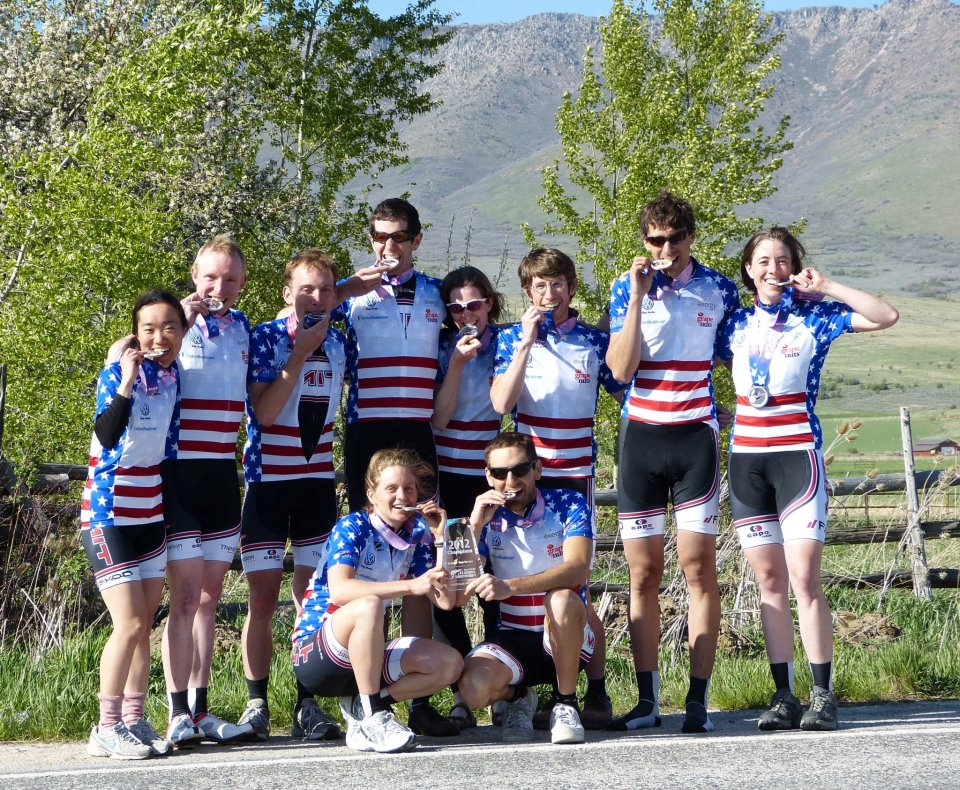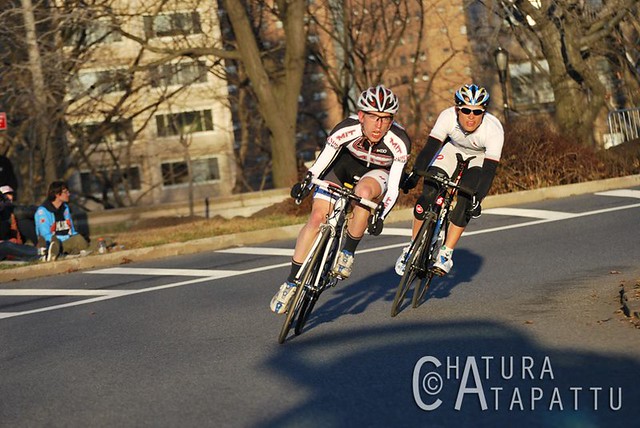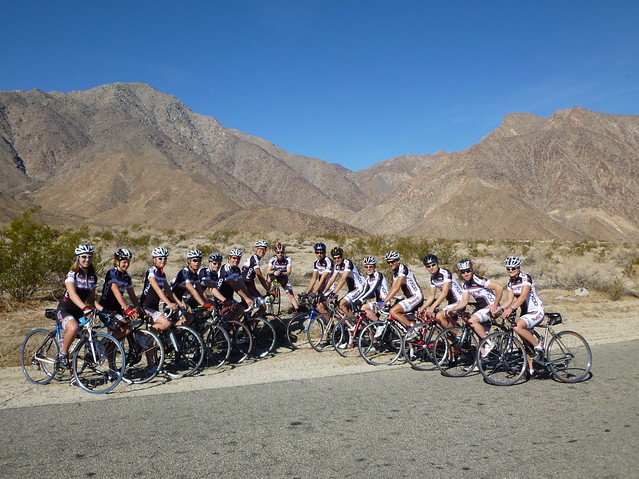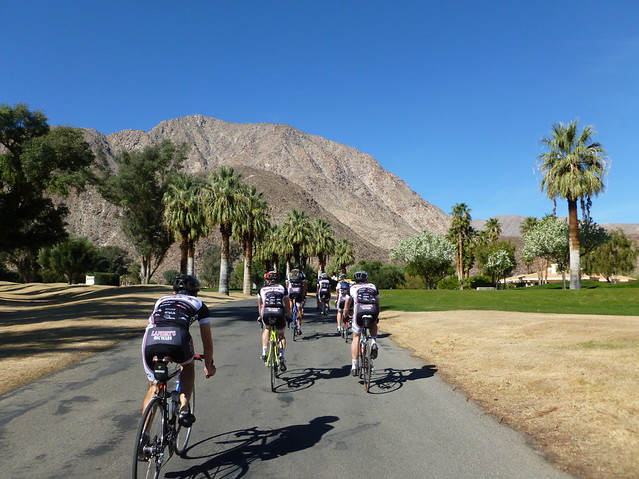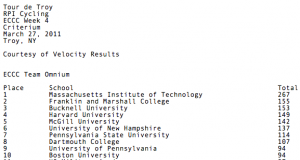On 4-6th May the MIT cycling team sent 10 riders (Katie Quinn, Yuri Matsumoto, Chris Birch, Laura Ralston (myself), Adam Bry, Spencer Schaber, Zack Ulissi, Andrew Lysaght, Sebastien Gauthier and Joe Near) and one support staff (Nate Dixon, also club president) to Ogden, Utah to compete in the National Collegiate Road Championships, and I’m proud to say that they won the team omnium for division 2 schools. We also filled the podium in all the women’s events: Katie Quinn took 1st in the road race (RR), 2nd in the criterium (crit) and 1st in the team time trial (TTT), Laura Ralston took 1st in the crit and 1st in the TTT, Chris Birch got 1st in the TTT, 3rd in the crit and 4th in the RR, and Yuri Matsumoto got 1st in the TTT, 4th in the crit and 5th in the RR. And the men did pretty well too with 2nd in the TTT and several respectable (mid-teens to early 20s) finishes in their RR and crit.
To enable you to re-live some of our Nationals moments I asked the riders to respond to a couple of questions about their experiences at the event and as team leaders over this wondrous season!
Laura Ralston: Katie, how does it feel to have captained such a strong women’s team for the last 2 years? What are your secrets to success?
Katie Quinn: The MIT women’s cycling team had a fantastic record of success long before I joined the team! It’s been an honor and loads of fun to captain and race with and learn from a team of the women who encouraged me to race in the first place! I think the ultimate achievement in cycling is having a team race their heart out to execute a thoroughly planned race strategy. I think the MIT women’s team does this at almost every race we do. Sometimes it doesn’t pay off … but sometimes it does and that’s an incredibly fun experience!
LR: Individually you had a fantastic set of results at Nationals – what were your best moments?
KQ: Hmmm.. I want to use the same idea as above but I guess you won’t use both answers anyway so..(LR: typical Katie – being as humble as ever!!!) I think the ultimate achievement in cycling is having a team race their heart out to execute a thoroughly planned race strategy. The best moments of Nationals were points of each race where I realized that we’d done exactly that…Crossing the finish line of the TTT together, knowing that our skill and discipline had got us over the course as efficiently as we could. The few laps of the crit where Laura and I pulled away together off the front of the race, knowing that we were both fully committed to stayed in the lead, and that Yuri would be strong and skilled enough to stop anyone chasing. That and then seeing Chris win the bunch sprint to take 3rd meant that we’d ticked off every goal that we had for the race!
The entire men’s team lifted in the road race. They started this last race of the weekend knowing that they had to beat our biggest competitor, Mars Hill College, to win the team omnium. Even though they were almost all caught behind a huge crash (more on this later) and had to waste energy chasing back to the race, they dug really deep and worked together really cleverly to each overtake one of Mars Hill’s strongest riders before the finish, securing our team win!
LR: Yuri, you were the most senior member of the team this year, and the only one who had been part of the 2008 Nationals Championship Road Team. How do the two experiences compare?
Yuri Matsumoto: When the team won in 2008, it was my first nationals and I had no idea that we were going to win the team omnium or women’s TTT, so, I was quite surprised and super excited about the win. As for this year, I think the team was stronger and we had higher expectations than we did in the past, so it was less of a surprise but I was equally thrilled to win again.
LR: What has collegiate cycling meant to you? Do you think you’ll try to stay involved after you graduate? (Sadly (for us) Yuri is planning to graduate in the next 12 months – she’s been in the team for over 5 years.)
YM: When I started cycling at the beginning of grad school, I had no idea how much fun I was going to have with collegiate cycling. Now I cannot imagine being in grad school and not racing bikes. It kept me happy whenever research was not going well which is like 99% of the time. If I live in Boston area after I graduate, I would like to stay in touch with the team.
LR: Chris, how did it feel winning the field sprint in the criterium? Did everything go to plan?
Chris Birch: I was unsure of where I would be this year because in late December, right before Cyclocross Nationals, I rolled my ankle and snapped a ligament in half. My road-specific training started late, and of all things, my sprinting was something I hadn’t trained up because of the injury. I knew I could outsprint most of our conference by the end of the season, but Nationals is a different beast. The criterium was definitely the race I was most looking forward to, and I knew my best chances were in a field sprint. With 3 laps to go, I never allowed myself to move farther back than 3rd wheel. With 1 to go, another ECCC woman (Jasmine from West Point) drove the pace, stringing the field out a bit, and I sat right on her wheel. I came around her after the penultimate corner and started a long sprint, passing Mariske (Mars Hill College — our biggest competition) in the final corner and coming through the finish first (3rd overall) with a sizable gap. I was so happy that I got to be a good teammate by helping make the MIT break successful and that I also got to achieve my personal goal of winning the sprint. Ultimately, I got 2nd in the individual omnium, just behind Katie, which was such a happy ending to my ankle-injury-missing- cyclocross-nationals story.
LR: To myself – tell us about your experience in the crit!
LR: Winning the collegiate criterium at 2012 USA Cycling Collegiate Road National Championships for the second year in a row was a fantastic moment. The day before the race my team mates and I had talked in length about the race and we had decided that if we could make a break happen with at least two Massachusetts Institute of Technology (MIT) riders in it that would be the safest way to guarantee podium spots.
We sat tight for the first two primes letting other riders do more work, and threw in some attacks immediately after the start/finish line. After about the third prime the maneuver started to break things up and with a bit of hesitation from the pack we were able to form a break of three – myself, my team mate Katie Quinn, and Mariske Strauss (the current South African cross country mountain bike champion and rider for Mars Hill College). We knew Mariske could be a strong rider, so we tried to be careful not to let have an easy ride in our break.
After a lap or so, she opened a gap on Katie’s wheel, so I let her suffer to see how tired she really was, and after another lap she was still not back on Katie’s wheel so I jumped past Mariske towards Katie. Katie managed to get my wheel and we dropped Mariske, and time trialed the rest the race.
When it came down to the last lap Katie agreed we should both start our sprints coming out the last corner but she was generous and gave me a lead-out coming into this corner, and I think she knew how much I really wanted the win – thanks Katie!!
LR: Adam and Spencer – as the current and previous men’s captains – you seem to have revolutionized the men’s side of the team, and shown that it’s not only MIT women that can win races in the ECCC! How did you manage this!? Is it sustainable – and what wisdom would you want to pass on to the next generation of MIT male cyclists?
Adam Bry: The club had an outstanding foundation thanks to the dedication of previous members and officers, but I think a lot of the credit for the success the men have had belongs to the current group of superstar women. They set an amazing example for how to train and prepare. A lot of what I tried to do as men’s captain was make sure that there were opportunities for the faster guys on the team to ride together and push each other. At this year’s training camp especially, we got in some great training together and it really paid off during the season.
Across all categories, I tried to make sure that we started races with a plan and intention to win. While it’s possible to win without that, bike racing is a sport that rewards those who go for it, and having the intention to win goes a long way towards actually doing it. For me this was a key piece of breaking through the mystique of the A field. It can be really intimidating to line up against pros and others that have been racing at a high level for most of the their lives, but once we all started to believe we could work together to win the races (even if we didn’t have the single strongest guy in the field) we got some great results.
Spencer Schaber: It wasn’t until I became captain that I started to believe that MIT men could actually win A or B category collegiate road bike races. I think training camp last year in Tucson, AZ and this year in Borrego Springs, CA with ~15 MIT riders each year really helped the men’s team get in a huge week of training at a near-ideal 4-5 weeks before racing season. Before these years, it was common for a smaller group (~5 riders?) to go and get that amount of training. On top of the clear effects on physical endurance, training camp brought in a new crop of riders and really got them hooked on the MIT Cycling community, so that they came to more races and became still stronger and smarter racers. With so many strong team members and great friendships, the next step was to get us working as a team for a team win.
When we had 5 men in the top 10 of the Tufts crit at Beanpot 2011 but no team win, we knew we had the strength to do better, and Alex Chaleff encouraged me to mobilize the team towards a team win. I sent out an e-mail to the A and B men trying to motivate them towards team wins for the rest of the season. This year Adam did a really great job proposing specific plans towards team wins (proposing roles in races to different people, and encouraging us all to work towards a team win if any MIT man got in a break), and he proposed strategies for riders in all categories to win, which led to better results for them and will continue to benefit them as they rise to higher categories knowing that they can win a bicycle race.
Finally, this year the training plan worked in more intensity than in past years, so that we were more ready for the races when they hit, rather than spending so much time “racing into shape”. I found the hard efforts at training camp over IAP to be especially helpful, including the “hammer rides”: ~5 mile stretches of targeted attacks with a defined finish line to try and reach first. Adam typically won these rides, but I remember one time when Zack U and I teamed up against Adam, and I gained a visceral experience for how well counter-attacking can work, because the two of us working together led to Adam not winning, for once! (Unfortunately, we still gave the win to Joe, if I remember correctly).
LR: Boys – what happened in that crash? What thoughts were running through your head at the time? Tell us about the climb and the descent!
Sebastien Gauthier: Since I was at the front of the race, I did not see the crash, and did not even realize it had happened until a long time into the race when I heard someone talk about it. I was surprised to hear that at least 20 riders went down. I think we should be very thankful that none of our riders were seriously injured in that big crash.
For the race, my job was to be at the front of the main group and control it during the first 3 laps of the flat loop. Specifically, I needed to pay more attention to any attacks or breakaway attempts by the Mars Hill racers and a few other key people. Mars Hill were important to watch because they were in second place for the team omnium, not too far behind us. With me being on the front and marking most attacks, the other MIT racers could hopefully stay in the pack and conserve as much energy as possible for the final climb.
Once we got to the bottom of the final climb, I was pretty much exhausted from the first part of the race. Since my job was done, I let the main pack climb away from me, hoping our guys would do well. It took me everything to make it to the top, but then the descent and the last 10km to the finish were just really fun. I was pleased to meet the other guys at the finish line and to hear them say that they had beaten all the Mars Hill guys at the finish, which probably meant we had successfully secured the first place for the team omnium.
AB: About 5 minutes into what figured to be a 3.5 hour race, flying along at 36 mph, I heard the unmistakable sound of brakes screeching and carbon splintering. At the last second as the riders in front of me slid into the pile I was confronted with a seething mass of people and
bikes piled 4 feet high, spread from one edge of the road to the other. In a split second I was part of the mess along with (I’m guessing) half the field. I’ve never seen anything like it and I hope
I never do again. There were clearly a lot of people in bad shape on the bottom of the pile, but luckily EMTs from the ambulance were there almost immediately. I got the attention of one of the neutral support guys, he fixed my stem which had torqued around by almost 90 degrees, everything else on my bike looked more or less okay, and off I went. The crash was so big and so early that I expected the pack would either get neutralized or slow down and wait, but as I chased solo with the pack no where in sight and only a few stragglers visible up ahead this seemed to not be the case, and I had the wrenching feeling that my race might be over before it had really started. After 10 minutes of catching and being caught I was in a group of 5 with two
other ECCC strong guys. We pushed it really hard and after 20 minutes we had the pack in sight as a carrot, and after 40 we’d caught back on.
Maybe from the chase and maybe just from a bad day, I started the major climb with dead legs. I felt a bit better as it went on, and by the top I had joined Spencer who was 20-30 seconds in front for most of the ascent. He’s a much better handler/descender than me, so following him down the nasty descent was a huge help. When we got to the bottom we could see a small group of riders up the road by maybe 30-40 seconds, and our job was pretty clear. We knew at least one Mars Hill guy was in front of us and we knew we needed to beat them to win the team omnium and earn our stars and stripes. With the goal so clear there was almost no verbal communication as we settled into an incredibly hard effort, taking turns drafting in the strong crosswind. We were definitely making progress on the riders in front of us – enough that we could see them as a group of two – but as we came across the 2 mile to go mark, we weren’t sure if we could get them before the line, so deeper into the paincave we went.
Finally at 1 mile to go they were just a few meters in front of us. While they were still just out of ear shot we made a quick plan: catch, sit on for a minute or so, one person attacks and the other
either counters or tries to win the sprint. After catching them we saw one was the Mars Hill guys (yes!). After drafting for a bit I felt I had some spring in my legs so I put in a hard attack with maybe 600 meters to the line which neither of them caught and Spencer came around Mars Hill in the sprint (yes!).
SS: We were going 36 mph down a flat, non-technical section of road, and the next thing I knew people were crashing all the way across the road. From ditch to ditch, there was a pile of carbon fiber and people skidding along the ground. I grabbed for brake but wasn’t able to avoid going down into the pile myself. I looked forward and saw a peloton of ~25 riders continuing on, looked around and saw no teammates, and hopped back on my bike, handlebars slightly askew, to chase. I worked with a couple other riders, and after maybe ten minutes we caught four more riders including Andrew, then we seven worked together—poorly—and finally caught the peloton just after the headwind turned to a tailwind after the dam. I was surprised the lower loop was not more restful considering how flat it was. Something about the winds made it require some effort at times even to sit in. Still, it was clear most people were just trying to sit in and save for the final ~10 miles including the main climb.
Sebastien worked very hard for us to shut down attacks, putting in one 15-second effort of 1 kW to chase down Robin Carpenter and many other efforts that surely tired him out, but allowed Adam, Zack, Andrew, and me to conserve energy. For the week leading up to the road race, I had been thinking to myself that the entire race would come down to a single ~20-minute effort, and it essentially did (apart from the 20-minutes spent chasing after the initial big crash). We caught the rider from his solo breakaway effort at the base of the climb, and for the first few minutes after the grade picked up I stayed with the leaders, including Carpenter and Grystar. I wanted to stay with them, at least for a while, in order to demoralize the competition behind me into reducing their efforts further. I was able to do that, but eventually I allowed a gap to open up from the leaders. A handful of riders passed me after I slowed down, and when I reached Katie, Laura, Yuri, and Chris, who told me that it was about 2 minutes to the leaders and 1 minute to the top. Most memorable was Laura yelling something like “THE OMNIUM IS UP THE ROAD! YOU NEED TO BE THERE!” (meaning the Mars Hill guy who passed me). That motivated me further to go at just below the limit where my legs would completely cramp and I would fall off my bike. I could feel myself grimacing—I was not smiling like I often do even under moderately hard efforts.
I crested the climb at about the same time as Adam and was pleased because we could work together on the final stretch to the finish line. I bombed down the descent as fast as I safely could, hitting 55 mph at one point, and met up with Adam again at the bottom. In the extreme crosswinds, the optimal arrangement for drag reduction sometimes put my front wheel even with the crank of his bike. I felt so “pro” trying to chase down the Mars Hill guy, perfectly working together with Adam at an all-out effort, still with my legs cramping and threatening to completely lock up. After the penultimate corner, we caught the Mars Hill rider and one other, sat on for a moment to rest, then Adam attacked and stayed ahead of him, and I sat on slightly longer then sprinted around Mars Hill at the end. At that point, I was pretty sure we had the team win!
LR: Joe, you perhaps had the worst luck at nationals this year, with 4 crashes in 2 days, and one broken bike – did you still manage to have fun out in Ogden – and if so, how? (Joe unfortunately was caught up in the big crash in the RR and had to retire as neutral support ran out of bikes, and he got caught up in 3 tumbles in the crit.)
Joe Near: I was surprised that there were so many crashes, and of course disappointed to be involved in so many of them (especially since I really haven’t crashed in my couple years of road racing). Worse than that was the feeling that I wasn’t able to do my job in the races because I kept crashing. But I always enjoy spending time with the team, and in the context of competing at nationals it was even more exciting. Watching everyone else race so well — in the women’s crit,
especially — was really satisfying, and standing on the podium with the team made all the crashes worth it.
LR: The men’s 2nd place in the TTT really helped nail down the team’s omnium win – how do you feel that race went, and what has helped you improve so much from last year?
AB: When we prerode the course we knew it would be good for us since there was a lot of wide open flat where we could use our strength and efficiency (our specialty) as opposed to some of the more technical courses we had during the season. We had 4 of the top 10 individual time trialists from the ECCC (our conference) on the team so we knew we had the strength. To give us the extra edge for Nationals, our title sponsor FXDD was extremely generous in providing rental ZIPP wheels which are more aerodynamic than standard wheels – especially in
the extremely windy conditions on the nationals course.
The ride itself was brutal. With a strong tail wind headed out it was very difficult to get any recovery while drafting. We reached the turnaround having averaged around 35 mph but everyone was pretty deep in the pain cave by that point. Coming back the headwind made for much better rest at the back of the paceline, but the efforts on the front were all the more sharp and painful. Fighting through the last 5 miles with everyone killing themselves on the front was draining but incredibly fun.
SS: A big change since last year was that three of the four men on the TTT squad went to training camp for a 32 hour week, and went to 7 or more of the 9 race weekends. We had more experience racing together, we (especially Zack U) considered pull lengths based on threshold power and frontal area of the members of the squad, we knew through and through that we should go harder on the upwind section based on journal articles analyzing optimal pacing for time trials as well as conventional cycling wisdom, we all four had deep-section aerodynamic wheels (vs. only two of the squad members last year), we had better aero helmets, and we communicated more frequently during the race, and switched our echelon formation as much as once every mile as the crosswind shifted. Thanks to FXDD for sponsoring our wheel rental—they must have been good for at least 12 seconds, so we probably would have gotten third or worse without those wheel rentals!
